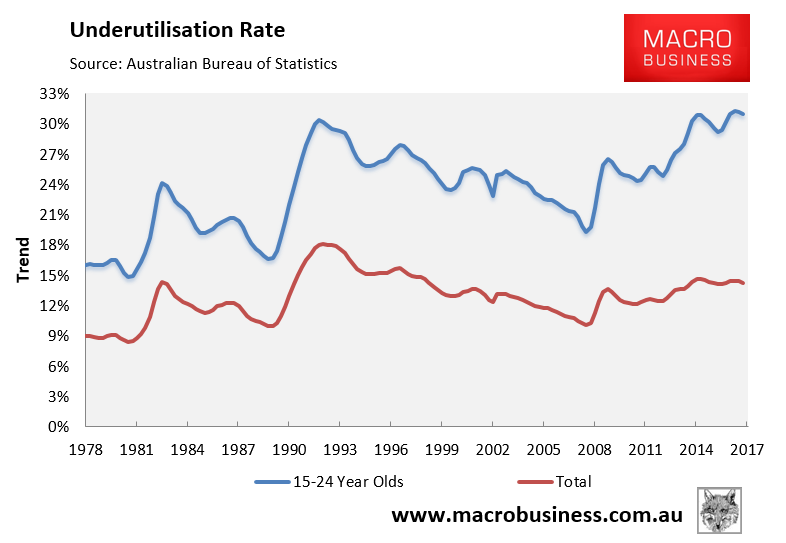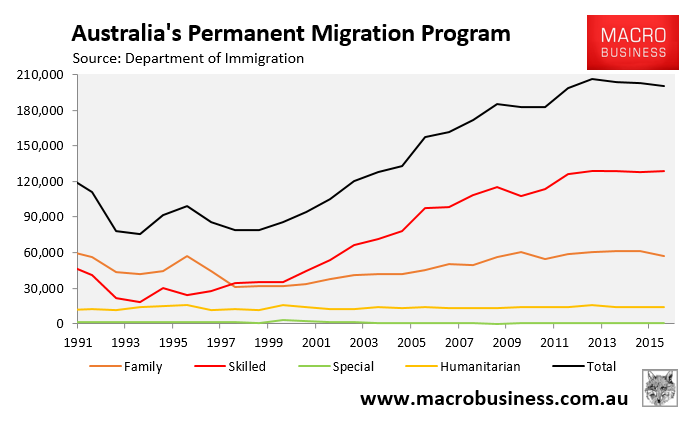Dr Bob Birrell from Australian Population Research Institute has argued that foreign students are locking younger Australians out of the jobs market. From the Herald-Sun:
TENS of thousands of foreign students are prolonging their stay in Australia by switching visas to become tourists, partners of local residents and even asylum seekers.
A massive 443,798 overseas students — a population the size of Canberra — were in the country as of June 30, and they all have the right to work up to 20 hours a week…
In 2016-17 across Australia about 200,000 foreign students already here got new visas, including 37,759 who transferred to the temporary graduate 485 visa allowing them to stay in Australia with full-time work rights for at least two years.
A further 39,945 former student visa holders got tourist visas, 10,685 scored the temporary skilled 457 visa, 8199 got to stay as spouses or betrothed of locals, and 864 convinced authorities that they were asylum seekers.
Demographer Dr Bob Birrell, from the Australian Population Research Institute, said the size of the foreign student population was mind-boggling, and it was clear that most wanted to extend their stay in Australia.
“It’s obvious that the attraction to come to Australia is primarily access to our job market and ultimately to permanent residency,” he said.
“The problem is that we have acute competition in the job markets that these temporary migrants are entering, and that has a massive significance for younger Australians who are moving from school into work without formal qualifications”…
[Birrell] said that federal authorities were dealing with a legacy of successive governments encouraging temporary entrants to stay for long periods in Australia.
As of December 31, 2016, there were 2.09 million temporary entrants here with work rights, including New Zealand citizens with special visas, foreign students, working holiday makers and temporary skilled workers.
The broad macro data backs up Dr Birrell’s claims. Since the Global Financial Crisis hit in 2008, the total number of jobs for people aged 15-24 years old has fallen by 1.2%, whereas full-time jobs have collapsed by 19.1%. And this comes despite a 7.5% lift in the 15-24 year old population over that period:

Meanwhile, the labour underutilisation rate for those aged 15-24 years old is close to the highest on record at 30.9%:

As it stands, young Australians are being crushed by increased competition for jobs, lower wages, as well as upward pressure on house prices in the migrant hotspots of Sydney and Melbourne. Meanwhile, the rest of us living in the major cities are suffering from worsening congestion, ever-rising infrastructure charges, and declining livability as the population swells year after year.
The reality is that Australia’s education system has become an integral part of the immigration industry and Australia’s population ponzi – effectively a way for foreigners to buy backdoor permanent residency to Australia.
Dr Jenny Stewart, Honorary Professor of Public Policy at the University of New South Wales, drew the direct link between permanent residency and foreign student demand in her excellent article Hooked on Students:
If you work in a university, you cannot help but be aware of the extent to which universities are dependent upon income from international undergraduate students. Many of us working in the sector realised that it was not for any intellectual brilliance on our part that the students came, but because for many, coming to Australia as a student was a significant step on the path to becoming an Australian resident…
What do these undergraduate students do once they have completed their qualification? Many, understandably, wish to remain in Australia…
With appropriate advice and support and the necessary persistence, it would seem to be possible for just about any international student who is a graduate of an Australian university to become, eventually, a permanent resident…
Underpinning this flood of students is the federal government’s permanent migrant intake, which has been set at the ridiculously high level of 200,000 (two-thirds “skilled”), which is 2.5 times the level that existed at the turn of the century and higher than at the peak of the mining boom:

It is unlikely that Australia’s education exports would be anywhere near as high if the carrot of permanent migration was not attached. That is, if Australia’s universities and vocational education providers had to compete solely on quality, they probably wouldn’t be able to stand on their own two feet.
Put another way, if this permanent migrant intake was lowered back to around 90,000, foreign students would have less opportunity to become permanent residents. Thus, their decision to study in Australia would be based solely on the prestige of Australia’s universities and the quality of teaching, not because it represents a backdoor way of migrating into Australia.
In reality, Australia’s education exports are to a large extent really “citizenship exports”. The broader implications for our education and training systems, the labour market, our infrastructure systems, and for housing markets, need to be much more carefully – and openly – thought through.

